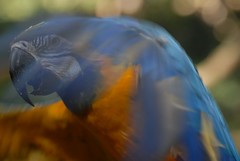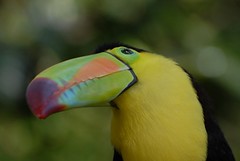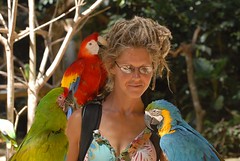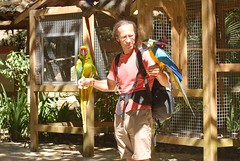
Blue Macaw Veil
Copan has been characterized by unreliable bowels and lots of work in between rest times. Time for a bit of magic! The Macaw Mountain bird park is set in a beautiful river valley under a steep mountain just outside Copan town. It’s a steep scenic walk to get there and a great day out when you’re there.
At one point the owner came and chatted. He moved all 90 birds from Roatan in the Bay Islands a few years ago (they are up to 150 birds now). Apparently they just went to sleep as soon as the plane engines began and woke up upon landing... much like children, and not quite the Dr Doolittle ark I’d envisaged.
The Macaws, toucans, parrots, owls and lorikeets in the park are all donated by people who find them injured, who shoot or catapult them off their crops and then bring them in injured, or who no longer want them as pets, or, wonderful to hear, by people who visit the park, realise their own homes and tiny cages are just not right for their pet birds and then bring them in to be cared for better.

Keel Bill
Some are breeding, so they must be happy, and all seem to have great personalities. The open air area is a riot (quite literally) and it’s clear that macaws especially just LOVE to stay in touch. One reason people bring birds in is because they talk incessantly and drive their people potty. Another is that some species are so intelligent they make overdemanding pets (the mind boggles! Kant before seed?)
My favourite intelligent bird was the small red and yellow fronted toucan who played with us for a good 40 minutes through the mesh of his enclosure (or her? she was VERY bright). She seemed to have a driving curiosity to KNOW, just to explore these new aspects of her environment. There was no sense of stress or of her mistaking Bill’s bag straps for food... it was just something new to explore and understand.
The magnificent red and blue macaws so beloved of the ancient Mayan people and indeed all ancient Mesoamericans (there was a roaring long-distance trade in feathers for centuries) are clearly necessarily social. They communicate almost nonstop in their unlovely squawks, mate for life (up to 100 years in the safety of captivity... how cool that most of those will be remembering things when I am long dead) and LOVE a good mutual preen, one eyes closed in ecstasy under the other’s intimate attentions.

Birds of a Feather
Bath time then food in the open area. I got absorbed in watching each different bird choose. Each feathered person has her own favourites from the maiz, fruit and seeds mixes, and pickiness is de rigeur (all the leftovers are later made available to the wild birds of the valley). I was sniffy about holding the birds - childish and somehow ‘not quite nice’, for the serious appreciater of wildlife. GET OVER IT GIRL! It was great. Their heavy bodies and calming grooming (how they loved my dreads) and I didn’t get pooed upon once. And in any case, if any of these birds stood a chance in the wild they’d be up for gradual release, but most have lived all or most of their lives as pets, and are probably just glad for birdy company, space and a stimulating environment now.

Q How do know when your parrot is stressed?
A ... it’s not a joke... They self-harm and pull out their own feathers.
There’s a special rehabilitation space for birds suffering from stress. These social birds could not cope with the small spaces and loneliness of their previous lives and need time to adjust, lose their sadness and heal in the unaccustomed company of their fellows. A few sad looking macaws sat aloof from each other with bedraggled feathers, no glorious tails and, I swear it, sadness in their downcast eyes. Happily, one pair seemed to be on the up and hung out nearer each other, even had the odd chat, and were regrowing their tails. So how do you know if they’re better? They stop pulling out their feathers, of course, and then are ready to be happy in a wider company.
Other special treats? Well I would have liked to see the big owls killing live chickens, but they do that at night... more to the owls schedule and less upsetting to the squeamish. The little owls, however, are fluffy bundles of viciousness and look just like the kind of birds you buy from large bins outside service stations that make a noise if you squeeze their tummies. (These would probably eat your thumbs if you squeezed their tummies.) They have false eyes on the back of the head, making them even more like blobs indistinguishable front and back.
Everything about the park is beautifully done and it’s a joy to spend time somewhere put together with such love, care and attention to aesthetic detail... this is clearly someone who did it for the birds, and not as a touristic money spinner. You can even have a swim if you want in a natural pool within the river.



No comments:
Post a Comment